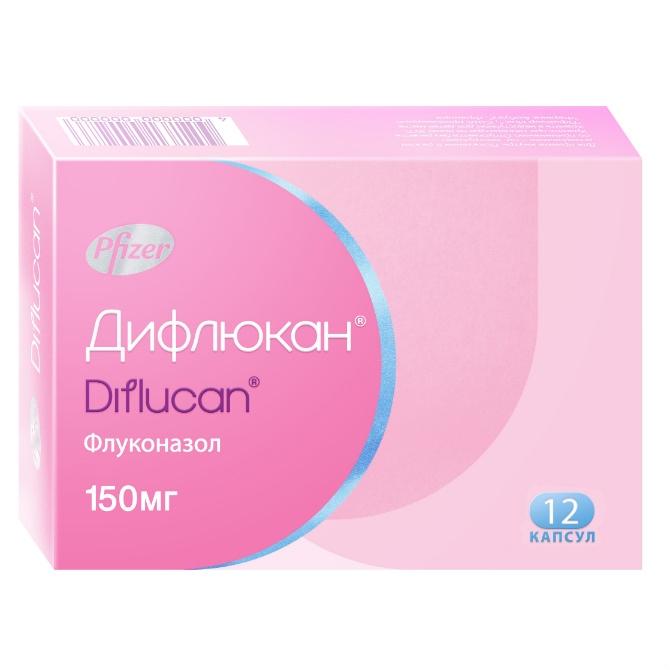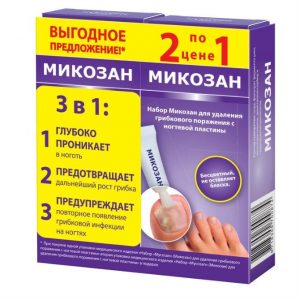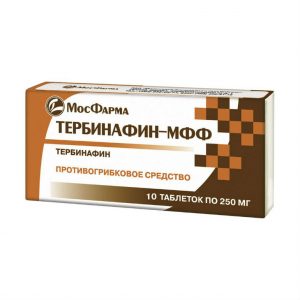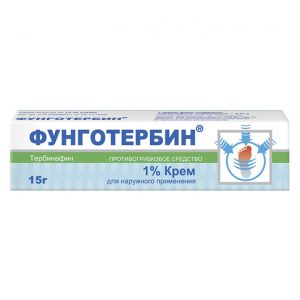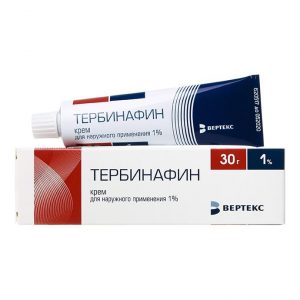Description
Latin name
Diflucan
Release form
Capsules
packaging 12 pcs
Indications
Vaginal candidiasis, acute or relapsing when topical therapy is not applicable to reduce the recurrence rate of vaginal candidiasis (4 or more episodes per year). Candidiasis balanitis when topical therapy is not applicable.
Contraindications
Hypersensitivity to fluconazole, other components of the drug or azole substances, simultaneous administration of terfenadine at a dose of 400 mg / day or more, drugs that increase the QT interval and are metabolized by the CYP3A4 isoenzyme, galactose intolerance, lactase intolerance, lactase deficiency, lactase deficiency age up to 3 years (for capsules).
Caution: liver failure, renal failure, rash on the background of fluconazole in patients with superficial fungal infection and invasive / systemic fungal infections, the simultaneous use of terfenadine and fluconazole at a dose of less than 400 mg / day, potentially proarrhythmic conditions in patients with multiple risk factors.
There is currently no evidence of a link between these congenital malformations and the use of low doses of fluconazole (150 mg once for the treatment of vulvovaginal candidiasis) in the first trimester of pregnancy. During pregnancy, fluconazole should be avoided, except in cases of severe and potentially life-threatening fungal infections, when the expected benefit of treatment outweighs the potential risk to the fetus. During the period of breastfeeding, the appointment of fluconazole is not recommended.
Use during pregnancy and lactation
Fluconazole should be avoided during pregnancy, except in cases of severe and potentially life-threatening fungal infections, when the expected benefits of the treatment outweigh the potential risk to the fetus.
Fluconazole is found in breast milk at the same concentrations as in the blood, therefore, Diflucan is not recommended for use during lactation (breastfeeding).
Composition
Each capsule contains:
active substance: fluconazole 150 mg
excipients: lactose 149.123 mg, corn starch 49.5 mg, colloidal silicon dioxide 0.352 mg, magnesium stearate 3.173 mg, sodium lauryl sulfate 0.352 mg capsule shell: titanium dioxide (E171) 1.47%, blue patented dye (E 131) 0.03%, gelatin up to 100%.
Ink for marking capsules 50 mg, 100 mg and 150 mg: shellac glaze 63%, black iron oxide (E172) 25%, N-butyl alcohol 8.995%, industrial methylated alcohol 74 OR 2%, soya lecithin 1%, anti-foam component DC 1510 0.005%.
Dosage and Administration
Inside. In acute vaginal candidiasis, candidiasis balanitis, the drug is used once inside at a dose of 150 mg. To reduce the recurrence rate of vaginal candidiasis, the drug can be used in a dose of 150 mg every three days – only 3 doses (on the 1st, 4th and 7th day), then a maintenance dose of 150 mg once a week. A maintenance dose can be used up to 6 months.
Side effects
Frequent: headache, abdominal pain, diarrhea, nausea, vomiting, increased serum activity of aminotransferases (AST, ALT) and alkaline phosphatase, rash.
Drug Interaction
Anticoagulants. Like other antifungal agents – azole derivatives, fluconazole, with simultaneous use with warfarin, increases PV (by 12%), in connection with which the development of bleeding (hematoma, bleeding from the nose and gastrointestinal tract, hematuria, melena) is possible. Patients receiving coumarin anticoagulants should be monitored continuously for PV.
Azithromycin. When co-administered with fluconazole at a single dose of 800 mg with azithromycin at a single dose of 1200 mg expressed pharmacokinetic interaction between both drugs has not been established.
Benzodiazepines (short acting). After ingestion of midazolam, fluconazole significantly increases midazolam concentration and psychomotor effects, with this effect being more pronounced after fluconazole ingestion than when administered intravenously. If concomitant benzodiazepine therapy is required, patients receiving fluconazole should be monitored for the appropriate dose reduction of benzodiazepine.
Cisapride. With the concomitant use of fluconazole and cisapride, adverse reactions from the heart are possible, including: fluttering / fluttering of the ventricles (torsade de point s). The use of fluconazole at a dose of 200 mg once daily and cisapride at a dose of 20 mg 4 times a day leads to a marked increase in plasma concentrations of cisapride and an increase in the QT interval on the ECG. Co-administration of cisapride and fluconazole is contraindicated.
Cyclosporine. In patients with transplanted kidney, the use of fluconazole at a dose of 200 mg / day leads to a slow increase in the concentration of cyclosporine. However, with repeated administration of fluconazole at a dose of 100 mg / day, no change in the concentration of cyclosporine in bone marrow recipients was observed. With the use of fluconazole and cyclosporine, it is recommended to monitor the concentration of cyclosporine in the blood.
Hydrochlorothiazide. Repeated administration of hydrochlorothiazide with fluconazole leads to an increase in plasma fluconazole concentration by 40%. The effect of this degree of severity does not require a change in the dosage regimen of fluconazole in patients receiving diuretics at the same time, but the doctor should take this into account.
Oral contraceptives. Concomitant use of combined oral contraceptive with fluconazole at a dose of 50 mg has no significant effect on the level of hormones, while the daily intake of 200 mg of fluconazole AUC of ethinylestradiol and levonorgestrel increase by 40 and 24%, respectively, and when receiving 300 mg of fluconazole The AUC of ethinyl estradiol and norethindrone increased by 24 and 13%, respectively. Thus, repeated use of fluconazole at these doses is unlikely to have an effect on the effectiveness of combination oral contraceptives.
Phenytoin. Concomitant administration of fluconazole and phenytoin may be accompanied by a clinically significant increase in phenytoin concentration. If both drugs are to be used concomitantly, phenytoin concentration should be monitored and dose adjusted accordingly to ensure serum therapeutic concentration.
Rifabutin. Concomitant use of fluconazole and rifabutin may increase serum concentrations of the latter. When fluconazole and rifabutin are used concomitantly, cases of uveitis have been reported. Patients receiving rifabutin and fluconazole should be closely monitored.
Rifampicin. Concomitant administration of fluconazole and rifampicin results in a 25% reduction in AUC and a fluconazole duration of T1 / 2 by 20%. Patients taking rifampicin at the same time should consider the feasibility of increasing the dose of fluconazole.
Sulfonylureas. Fluconazole, co-administered, leads to an increase in T1 / 2 oral preparations of sulfonylurea (chlorpropamide, glibenclamide, glipizide and tolbutamide). Patients with diabetes can be prescribed the combined use of fluconazole and oral preparations of sulfonylurea, but the possibility of developing hypoglycemia should be considered.
Tacrolimus. Concomitant use of fluconazole and tacrolimus leads to an increase in serum concentrations of the latter. Cases of nephrotoxicity are described. Patients receiving both tacrolimus and fluconazole should be closely monitored.
Terfenadine. With the use of azole antifungal agents and terfenadine, serious arrhythmias may occur as a result of increasing the QT interval. No increase in QT interval was observed with fluconazole 200 mg / day, however, the use of fluconazole at doses of 400 mg / day and above causes a significant increase in the plasma concentrations of terfenadine. Concomitant administration of fluconazole at doses of 400 mg / day or more with terfenadine is contraindicated (see Contraindications section). Fluconazole treatment at doses less than 400 mg / day in combination with terfenadine should be closely monitored.
Theophylline. When co-administered with fluconazole at a dose of 200 mg for 14 days, the average plasma clearance rate of theophylline is reduced by 18%. When fluconazole is given to patients receiving theophylline at high doses or to patients at increased risk of theophylline toxicity, the symptoms of theophylline overdose should be monitored and, if necessary, the therapy adjusted accordingly.
Zidovudine. When co-administered with fluconazole, there is an increase in concentrations of zidovudine, which is probably due to a decrease in the metabolism of the latter to its major metabolite. A significant increase in zidovudine AUC (20%) was found before and after treatment with fluconazole at a dose of 200 mg / day for 15 days in patients with AIDS and ARC (AIDS-related complex).
When administered to HIV-infected patients, zidovudine at a dose of 200 mg every 8 h for 7 days in combination with or without fluconazole at a dose of 400 mg / day showed a significant increase in zidovudine AUC (74%) between the two regimens. when co-administered with fluconazole. Patients receiving this combination should be observed to identify side effects of zidovudine.
Concomitant use of fluconazole with astemizole or other drugs metabolised by the cytochrome P450 system may be accompanied by increased serum concentrations of these agents. Caution should be exercised when fluconazole is administered concomitantly in the absence of reliable information. Patients should be carefully observed.
Studies on the interaction of oral forms of fluconazole with its ingestion with food, cimetidine, antacids, as well as after total body irradiation to prepare for bone marrow transplantation have shown that these factors have no clinically significant effect on the absorption of fluconazole.
These interactions have been established with repeated use of fluconazole to interact with drugs as a result of single administration of fluconazole.
Doctors should note that interaction with other drugs has not been specifically studied, but it is possible.
overdose
Symptoms: fluconazole overdose has been reported, and in one case, a 42-year-old HIV-infected patient had hallucinations and paranoid behavior after taking 8200 mg of the drug. The patient was hospitalized and his condition normalized within 48 hours.
Treatment: symptomatic treatment (including supportive measures and gastric lavage).
Fluconazole is excreted mainly in the urine, so forced diuresis can probably accelerate the elimination of the drug. A 3-hour hemodialysis session reduces plasma fluconazole levels by about 50%.
Storage conditions
Store at a temperature not exceeding 30 ° C, out of the reach of children.
Prescription conditions from
pharmacies Prescription
Active ee substances
Fluconazole
pharmacy leave terms without a prescription
dosage form
dosage form
capsules
